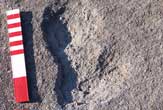
In July, British researchers dropped a bombshell by reporting the discovery of 40,000-year-old human footprints in a layer of volcanic ash in central Mexico. The finding was highly controversial because it challenged the traditionally accepted view that humans first arrived in North America around 11,000 years ago after crossing the Bering Strait, a land bridge that once connected Russia and Alaska.
In a new twist, other scientists have performed their own dating of the volcanic ash and obtained wildly different results.
Using palaeomagnetic analysis—a technique that looks at the Earth's magnetic field during past geologic time—and a radioactive dating technique called argon-argon, the team concludes the ash is actually 1.3 million years old.
Revolutionary discovery?
Sylvia Gonzalez, a geoarcheologist from Liverpool John Moores University, and colleagues, found the purported footprints at the bottom of an abandoned quarry near Cerro Toluquilla, a volcano located near the Mexican city of Puebla. Gonzalez claimed there were about 269 footprints, made by both animals and humans.
"If these really are footprints, and they were made 1.3 million years ago, that would be absolutely revolutionary," said Paul Renne, a geologist at the University of California, Berkeley who was involved in the new dating.
Humans are not thought to have even been around 1.3 million years ago. According to most scientific estimates, modern humans didn't begin appearing in Africa until about 200,000 years ago. If the markings really are footprints, then it would mean one of two things: either humans appeared much earlier than previously thought or the footprints were made by an early ancestor of humans like homo erectus.
Get the world’s most fascinating discoveries delivered straight to your inbox.
Renne thinks both possibilities are extremely unlikely. So where does that leave things?
Man, cow or machine
After visiting the site, Renne believes the markings are not really human footprints at all, but rather impressions left by machines or animals that have passed through the quarry in recent times.
"You have to remember this is a public area," Renne said in a telephone interview. "Vehicles drive across it, you can see tire tracks on the surface. There are cows and other animals grazing nearby."
Gonzalez told LiveScience that she and her colleagues will reply to Renne's findings formally in a scientific paper, but said that one possible reason for the large discrepancy in dating may be due to the mixed nature of the volcanic ash.
"There are very different particles in there," Gonzalez said. "This ash has got a very particular mineralogy that is very difficult to date."
- Top 10 Missing Links
- Footprints in Mexico Create Scientific Stir
- Oldest Walking Human Ancestor Said Found
- Jogging Separated Humans from Apes
- 'Hobbit' Brain Reconstructed


